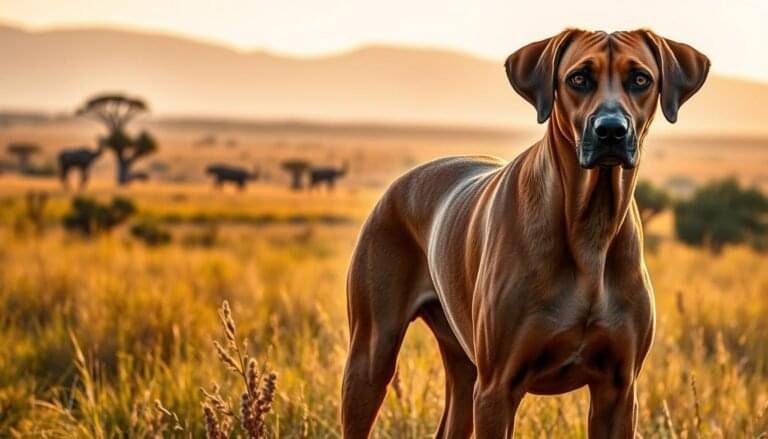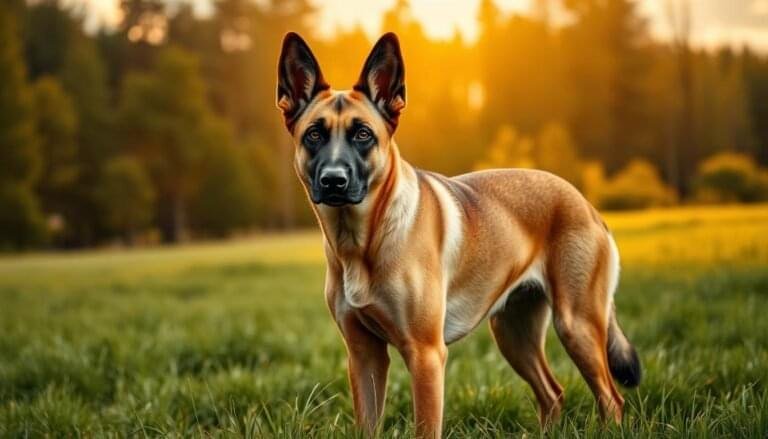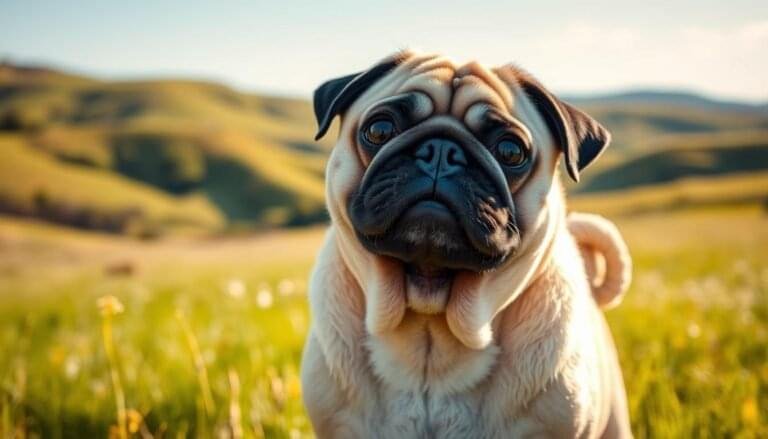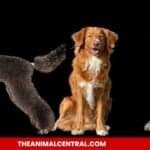Affenpinscher vs Brussels Griffon: Did you know that both Affenpinschers and Brussels Griffons live for 12 to 15 years? This fact shows how long these cute toy breeds can live. They are often called “monkey dogs.” Let’s look at the differences between these two breeds to see which one might be right for you.
Affenpinschers and Brussels Griffons are similar in many ways. They are both small and loving dogs. Affenpinschers are a bit taller, reaching 9 to 11.5 inches. Brussels Griffons are shorter, between 7 to 12 inches. Their small size makes them great for city living. But, each breed has its own special personality.
Both breeds need a lot of grooming because of their unique fur. But, they are different in how they act. Affenpinschers are playful and curious. Brussels Griffons are loving and full of energy. These traits are important when choosing a breed that fits your family and lifestyle.
Key Takeaways
- Both breeds have a life expectancy of 12 to 15 years
- Affenpinschers are slightly taller than Brussels Griffons
- Both require high grooming maintenance
- Affenpinschers are playful and curious
- Brussels Griffons are affectionate and lively
- Both breeds are classified as toy dogs
- Choosing between them depends on personality preferences and lifestyle
Understanding the Origins and History
The Affenpinscher and Brussels Griffon are both charming terrier types with fascinating histories. They come from European soil and share some similarities. Yet, each has its own unique story.
German Roots: The Affenpinscher Story
The Affenpinscher’s story starts in 15th century Germany. They were bred as small terriers to catch rats and mice. These dogs were essential in keeping homes and stables pest-free.
By the 18th century, they evolved into smaller, more refined pets. They became beloved companions.
Belgian Heritage: The Brussels Griffon Evolution
The Brussels Griffon came from 19th century Belgium. Like their German cousins, they were originally ratters in stables. They were developed from a mix of breeds, including Pugs, Toy Spaniels, and Affenpinschers.
Historical Purposes and Breed Development
Both breeds changed from working dogs to beloved companions. The Affenpinscher was recognized in 1895 by the Pinscher Klub in Cologne. The Brussels Griffon developed between 1870 and 1880.
| Breed | Origin | Original Purpose | Key Development Period |
|---|---|---|---|
| Affenpinscher | Germany | Ratting | 15th – 19th century |
| Brussels Griffon | Belgium | Ratting | 19th century |
Today, these breeds enchant dog lovers with their charm and rich histories. They are cherished as companion pets.
Physical Characteristics and Appearance
Affenpinschers and Brussels Griffons are toy breeds with unique features. They share some traits but also have distinct differences.
Size and Weight Comparisons
Affenpinschers are a bit taller than Brussels Griffons. Affenpinschers reach 9-11.5 inches at the shoulder. Brussels Griffons are shorter, at 7-8 inches.
Both breeds weigh about the same. Affenpinschers weigh 7-10 pounds. Brussels Griffons weigh 6-12 pounds.
Coat Types and Colors
Both breeds have hypoallergenic coats, great for those with allergies. Affenpinschers have a single, wiry coat in black, gray, silver, or red. Brussels Griffons have a double coat with more color options.
Because of their coats, their grooming needs are a bit different.
| Breed | Coat Type | Colors | Grooming Frequency |
|---|---|---|---|
| Affenpinscher | Single, wiry | Black, gray, silver, red | 2-3 times per week |
| Brussels Griffon | Double coat | Red, black, tan, beige | 3-4 times per week |
Facial Features and Expression
Affenpinschers have a monkey-like face with a short muzzle and round, dark eyes. Brussels Griffons have a flat face with a pushed-in nose and large, expressive eyes. Both breeds have charming expressions.
Knowing these physical traits helps choose the right breed. Regular grooming is key to keeping their hypoallergenic coats and cute looks.
Affenpinscher vs Brussels Griffon: Key Differences
I’ve looked into the differences between Affenpinschers and Brussels Griffons to help you pick the right pet. These small dogs have some similarities, but they also have unique traits.
Size and Structure Variations
Affenpinschers are a bit bigger, standing 9-11.5 inches tall and weighing 7-13 pounds. Brussels Griffons are more compact, measuring 7-8 inches and weighing 5-15 pounds. Both have a sturdy build. But Affenpinschers have a shaggy coat, while Brussels Griffons have a double coat.
Temperament and Personality Traits
Affenpinschers are smart and confident. They bark a lot, making them good watchdogs. Brussels Griffons are more sensitive and quiet, barking less. Both breeds are loving, but Brussels Griffons bond more with their owners.
Exercise and Energy Levels
Affenpinschers need daily walks and play. Brussels Griffons need up to 30 minutes of activity a day. Both do well in apartments but need mental challenges to avoid boredom. Regular exercise is key to keep them healthy and prevent weight gain.
| Characteristic | Affenpinscher | Brussels Griffon |
|---|---|---|
| Height | 9-11.5 inches | 7-8 inches |
| Weight | 7-13 pounds | 5-15 pounds |
| Coat Type | Shaggy | Double coat |
| Barking Tendency | Frequent | Occasional |
| Exercise Needs | Moderate | Up to 30 minutes daily |
Health Considerations and Lifespan
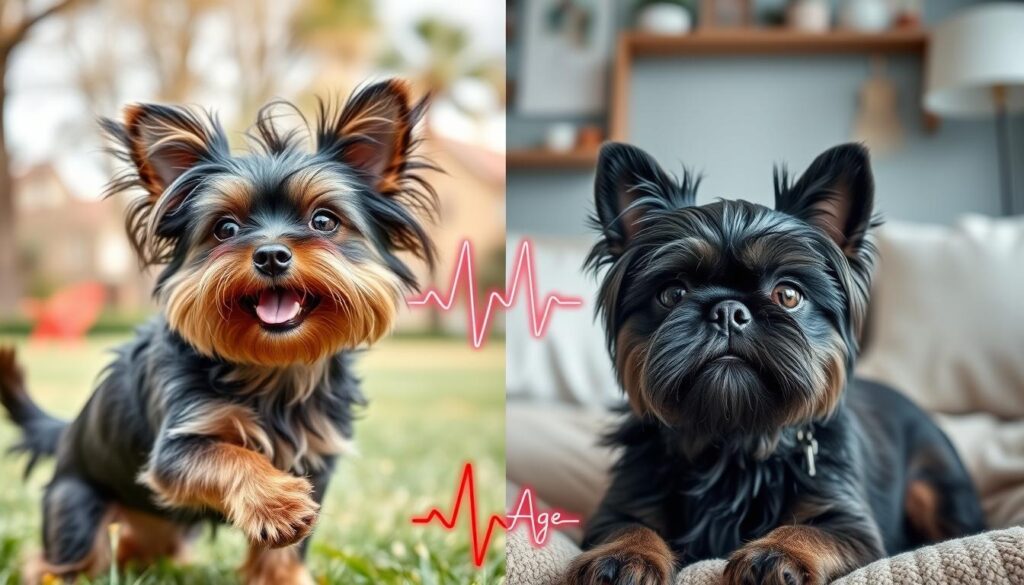
Affenpinschers and Brussels Griffons have similar health needs and lifespans. Affenpinschers live 12-14 years, while Brussels Griffons can live up to 15 years. These small dogs make the most of their long lives.
Each breed has its own health challenges. Affenpinschers might get collapsed trachea, cataracts, or heart murmurs. Brussels Griffons often face patellar luxation and hip dysplasia. It’s key for owners to know these health differences.
| Breed | Lifespan | Common Health Issues | Weight Range |
|---|---|---|---|
| Affenpinscher | 12-14 years | Collapsed trachea, cataracts, heart murmurs | 7-13 pounds |
| Brussels Griffon | 12-15 years | Patellar luxation, hip dysplasia, allergies | 5-15 pounds |
Regular vet visits are vital for both breeds. Even though they’re similar in size, their health needs vary. Knowing these differences ensures a long, happy life for these dogs.
Training and Intelligence Comparison
When we look at Affenpinschers and Brussels Griffons, their training and smarts are quite different. These traits affect how well they adjust to new places and learn commands.
Learning Capacity and Trainability
Affenpinschers are smarter, learning commands in 15-25 tries. Brussels Griffons might take 40-80 tries. This affects how easy they are to train and how much exercise they need.
Common Behavioral Challenges
Both breeds can be stubborn. But Affenpinschers are more independent. Brussels Griffons are more sensitive, which can cause anxiety if they’re not socialized right.
Best Training Approaches for Each Breed
For Affenpinschers, short, fun training sessions work best. Brussels Griffons need patience. Both do well with positive, consistent training.
| Breed | Intelligence Ranking | Training Difficulty | Recommended Exercise |
|---|---|---|---|
| Affenpinscher | Higher | Moderate | 30-45 min/day |
| Brussels Griffon | Medium | Challenging | 20-30 min/day |
Knowing the differences in their traits and exercise needs helps us set realistic goals for training. Affenpinschers might do well in obedience. Brussels Griffons are great companions.
Living Requirements and Adaptability
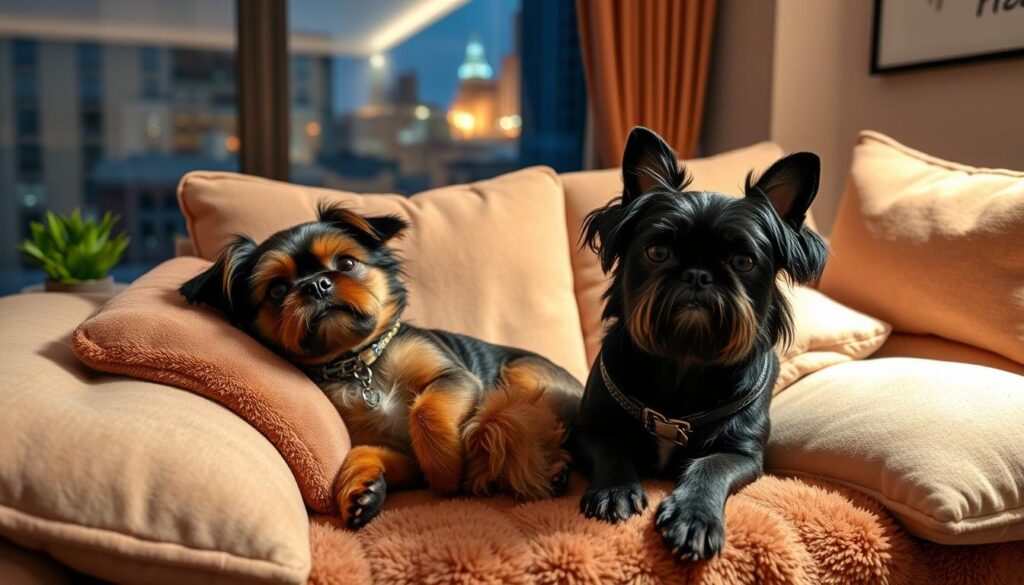
When thinking about getting a pet like an Affenpinscher or a Brussels Griffon, it’s important to know their needs. These small dogs are great for living in apartments. But, they have special needs that owners should think about.
Space Needs and Housing Considerations
Affenpinschers and Brussels Griffons do well in small spaces. Affenpinschers are 9-11 inches tall and weigh 5-9 pounds. They need about 20 minutes of playtime each day.
This makes them perfect for apartment living. Just make sure they get enough mental challenges.
Climate Tolerance
Affenpinschers prefer warmer weather, while Brussels Griffons like cooler temperatures. It’s vital to keep these small dogs safe from extreme weather.
Family Compatibility
Both breeds are loyal family pets. Early socialization helps Affenpinschers not be too territorial. They are great guard dogs, despite their size.
Brussels Griffons are also very loving but can be stubborn. They need patience during training.
Even though these dogs adapt to different homes, they need regular exercise and mental challenges. Meeting their needs ensures they are happy and healthy in any home.
Grooming and Maintenance Needs
Affenpinschers and Brussels Griffons have different grooming needs. Affenpinschers have a shaggy coat that needs regular care. Brush them at least twice a week to avoid matting.
Their coats can be smooth, rough, or a mix. Each type needs special care.
Brussels Griffons come in rough and smooth coats. The rough-coated ones need more grooming. Both types should be brushed weekly to keep their coats healthy.
| Breed | Coat Type | Grooming Frequency | Shedding Level |
|---|---|---|---|
| Affenpinscher | Single coat | Every 4-6 weeks | Moderate |
| Brussels Griffon | Double coat | Twice a week | Low |
Both breeds have hypoallergenic coats, good for those with allergies. But, no dog is completely hypoallergenic. Regular grooming helps manage shedding and reduces allergens at home.
Affenpinschers need professional grooming every 4-6 weeks. Brussels Griffons do better with more frequent grooming at home to keep their coats looking great.
Social Behavior and Family Integration
Choosing a pet means understanding their personality. The Affenpinscher and Brussels Griffon have special ways of acting. This affects how they fit into a family. Let’s look at how they get along with kids, other pets, and their need for company.
Interaction with Children
Brussels Griffons love being close to their family, making them great with kids. Affenpinschers might take a bit longer to warm up to children. It’s important to socialize them early to ensure they get along well.
Studies show dogs trained early, within 12 weeks, do better. They behave better.
Compatibility with Other Pets
Both breeds can live with other pets if they’re introduced slowly. Their small size might make them cautious around big animals. Affenpinschers, with their hunting background, might chase small animals.
Watching them when they meet other pets is best. Slow introductions help them get along.
Social Needs and Independence Levels
Affenpinschers and Brussels Griffons need daily interaction. They should get about 30 minutes of exercise a day. This keeps them healthy and happy.
Despite being small, they have big personalities. They love being part of family activities. They form strong bonds with their owners, showing loyalty and love.
Even though they enjoy company, they can also be independent. This makes them flexible for different homes, from apartments to houses with yards. Meeting their social needs is key to avoid bad behaviors like barking too much or getting anxious when left alone.
Conclusion
In the debate between affenpinschers and Brussels Griffons, we see two delightful pets. They are small, loving, and full of life. The Brussels Griffon, known by the American Kennel Club as a Toy Breed, weighs 8-10 pounds and is 7-8 inches tall. They live for 12-15 years, making them great long-term family pets.
Grooming is different for each breed. Brussels Griffons, with their rough coats, need weekly brushing and stripping a few times a year. They also need baths every 4-6 weeks and daily eye cleaning to avoid tear stains. They should get about 30 minutes to an hour of activity daily, split into two 15-minute walks.
Health is another important factor. Brussels Griffons might face eye injuries or serious issues like luxating patella. About 25-30% of small breeds could have breathing or eye problems. Early socialization and training are key for both breeds to grow into well-adjusted dogs.
Choosing between an affenpinscher and a Brussels Griffon depends on your lifestyle and preferences. Both are excellent pets for dog lovers. Their tendency to stick close to their owners makes them perfect for those who want a loyal companion.
FAQ
Are Affenpinschers and Brussels Griffons good apartment dogs?
Which breed is more hypoallergenic?
Do Affenpinschers and Brussels Griffons get along with other pets?
Which breed is easier to train?
Are these breeds good with children?
How much grooming do Affenpinschers and Brussels Griffons require?
Which breed is more vocal?
Are these breeds prone to any specific health issues?
References
https://en.wikipedia.org/wiki/Affenpinscher
| American Kennel Club (AKC) | https://www.akc.org/dog-breeds/ |
| United Kennel Club (UKC) | https://www.ukcdogs.com/ |
| Canadian Kennel Club (CKC) | https://www.ckc.ca/en |
| Fédération Cynologique Internationale (FCI) | https://www.fci.be/ |

